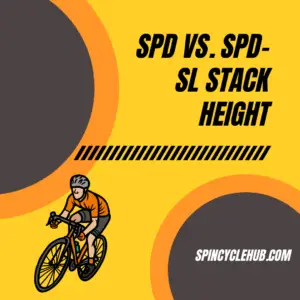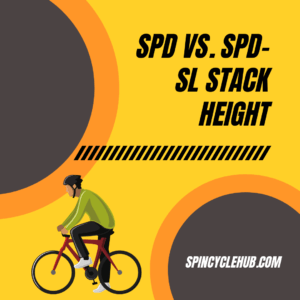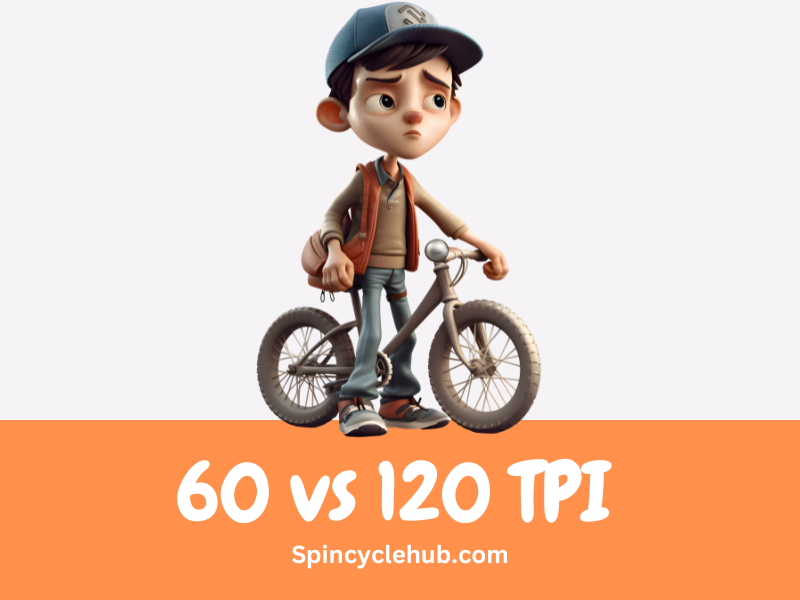Introduction
When it comes to cycling, having the right gear can make a world of difference in your performance and overall enjoyment on the bike. And one key component that can significantly impact your riding experience is the choice of pedals. Among the many pedal systems available, two popular options are Shimano’s SPD (Shimano Pedaling Dynamics) and SPD-SL (Shimano Pedaling Dynamics – Super Light). In this article, we’ll dive into the topic of stack height and explore the differences between SPD and SPD-SL in terms of how they affect your cycling experience.
Understanding Stack Height
Before we delve into the specifics of SPD and SPD-SL stack heights, let’s first understand what stack height actually refers to. Stack height is the distance between the pedal spindle and the sole of your cycling shoe when the cleat is mounted. In simpler terms, it measures how high your foot will sit above the pedal axle.

Stack height plays a crucial role in cycling because it affects various aspects of your riding experience, including power transfer, pedaling efficiency, bike fit, and body alignment. Therefore, it’s essential to consider stack height when choosing your pedals.
SPD Pedals and Stack Height
The SPD pedal system, widely popular among mountain bikers, offers a practical and versatile option for cyclists. In terms of stack height, SPD pedals tend to have a lower profile compared to other pedal systems. This lower stack height brings your foot closer to the pedal axle, resulting in a more direct transfer of power from your legs to the bike.
The advantage of the lower stack height in SPD pedals is that it provides better stability and control, especially in off-road conditions. The closer proximity of your foot to the pedal axle allows for efficient power transfer, which is crucial for technical climbs and aggressive maneuvers on the trails.
However, it’s important to note that the lower stack height can potentially cause issues for cyclists with limited ankle mobility or those who prefer a more relaxed foot position. Additionally, the reduced stack height may require adjustments in bike fit and saddle height to maintain proper body alignment.
SPD-SL Pedals and Stack Height
On the other hand, SPD-SL pedals are commonly used in road cycling and are favored by many road cyclists, including professionals. These pedals are designed with a larger surface area and a wider platform, providing enhanced stability and support for road riding.
When it comes to stack height, SPD-SL pedals generally have a higher profile compared to SPD pedals. This increased stack height places your foot slightly higher above the pedal axle. The higher stack height in SPD-SL pedals can offer benefits for road cyclists, such as improved pedaling efficiency and increased leverage during powerful sprints and climbs.
However, the higher stack height of SPD-SL pedals may feel less stable for riders who are used to the lower stack height of SPD pedals. Additionally, the increased distance between the foot and pedal axle can potentially lead to a less efficient transfer of power for riders with limited flexibility or those who prioritize comfort over pure performance.
Comparing SPD and SPD-SL Stack Heights
Now that we have explored the stack heights of SPD and SPD-SL pedals individually, let’s compare them directly. It’s important to note that the exact stack height measurements may vary between different pedal models and shoe combinations. However, in general, SPD pedals have a lower stack height ranging from around 18mm to 25mm, while SPD-SL pedals tend to have a higher stack height ranging from approximately 32mm to 39mm.
The difference in stack height between SPD and SPD-SL pedals can have several implications. The lower stack height of SPD pedals promotes a more connected and responsive feel, particularly for off-road riding. It allows for better power transfer and can enhance control in technical terrain.
On the other hand, the higher stack height of SPD-SL pedals can be advantageous for road cyclists who prioritize efficiency and power output. The additional height provides a biomechanical advantage during intense efforts, helping to maximize the transfer of power to the pedals.
Factors to Consider in Choosing Pedals
When deciding between SPD and SPD-SL pedals, it’s crucial to consider various factors beyond just stack height. Your choice should align with your specific cycling discipline, riding style, and personal preferences. Here are a few key factors to keep in mind:
1. Cycling Discipline and Riding Style: Consider whether you primarily ride off-road or on the road. SPD pedals are generally favored for mountain biking and gravel riding, while SPD-SL pedals are popular in road cycling.
2. Personal Preference and Comfort: Determine your priorities in terms of comfort, foot position, and pedaling dynamics. Some cyclists prefer the secure feeling of SPD pedals, while others may prefer the larger platform of SPD-SL for long-distance rides.
3. Shoe Compatibility: Ensure that your cycling shoes are compatible with the pedal system you choose. SPD pedals typically require shoes with two-bolt cleat systems, while SPD-SL pedals use three-bolt cleats.
4. Cleat Engagement and Release Mechanisms: Consider the ease of clipping in and out of the pedals, as well as the adjustability of the release tension. Some riders may prefer the quick and effortless engagement of SPD pedals, while others may value the firm and stable engagement of SPD-SL.
5. Weight and Durability: Evaluate the weight and durability of the pedal systems, as this can impact your overall cycling performance and longevity of the pedals.
6. Maintenance and Ease of Use: Consider the maintenance requirements and ease of pedal installation and adjustment. Some pedal systems may require more frequent servicing than others.
Expert Opinions and Recommendations
To gain further insights into the choice between SPD and SPD-SL pedals, it can be helpful to consider expert opinions and recommendations. Professional cyclists, bike fitters, and experienced riders often have valuable insights based on their own experiences and preferences. Seek advice from cycling communities, local bike shops, or professional fitting services to help guide your decision.
It’s worth noting that pedal choice can vary among different cycling disciplines and even individual riders within the same discipline. Ultimately, the best pedal system for you is the one that aligns with your specific needs, goals, and riding style.

Conclusion
Choosing the right pedals for your cycling adventures is a crucial decision. When it comes to stack height, the differences between SPD and SPD-SL pedals can significantly impact your riding experience. SPD pedals offer a lower stack height, providing enhanced control and stability for off-road riding. On the other hand, SPD-SL pedals have a higher stack height, delivering improved pedaling efficiency and power transfer for road cycling.
Consider your cycling discipline, personal preferences, and shoe compatibility when making your pedal selection. And don’t hesitate to seek expert advice and recommendations to help guide your decision-making process. Remember, the perfect pedal choice is the one that brings you the most joy, comfort, and performance on your bike.
FAQs
Q1: Can I use SPD shoes with SPD-SL pedals, or vice versa?
A: No, SPD and SPD-SL pedals have different cleat systems, and their shoes are not cross-compatible. SPD pedals require shoes with two-bolt cleats, while SPD-SL pedals use three-bolt cleats.
Q2: Are SPD pedals suitable for long road rides?
A: While SPD pedals are commonly used for off-road riding, they can be used for road cycling as well. However, keep in mind that their smaller platform and recessed cleats may not provide the same level of pedaling efficiency and power transfer as SPD-SL pedals during intense road efforts.
Q3: Can I adjust the stack height on SPD and SPD-SL pedals?
A: The stack height of pedals is determined by their design and cannot be easily adjusted. However, you can make slight adjustments to your bike fit and saddle height to accommodate the differences in stack height between the two pedal systems.
Q4: Do stack height differences affect shoe cleat wear?
A: The stack height itself does not directly impact shoe cleat wear. However, differences in stack height may require adjustments in cleat positioning, which can affect the wear pattern on your shoe cleats. Regularly inspect and replace worn cleats to maintain optimal performance and safety.
Q5: Can I use SPD or SPD-SL pedals with any cycling shoe?
A: SPD and SPD-SL pedals have specific cleat systems, so you need compatible shoes to use these pedal systems. Make sure to check the compatibility of your cycling shoes with the pedal system you choose before making a purchase.
- The Lowdown on Stack Height
- This article from outsideonline dives deeper into the concept of stack height and its significance in cycling. It discusses how stack height affects power transfer, bike fit, and overall performance.
- SPD vs SPD-SL: What’s the Difference?
- cyclingnews provides an informative guide comparing SPD and SPD-SL pedal systems. The article covers various aspects, including stack height, cleat systems, shoe compatibility, and recommendations for different cycling disciplines.
Watch this one,
Video Credits – West Point Cycles
DOWNLOAD THIS ARTICLE :Click Here
You May Also Like



